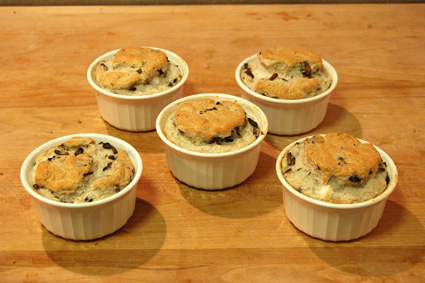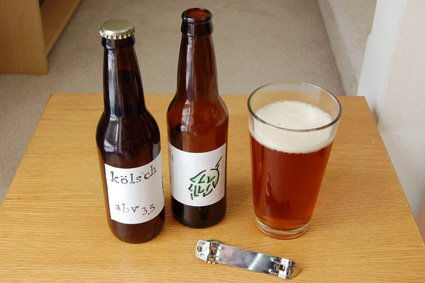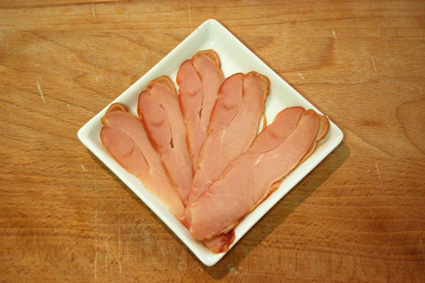It's been a weekend of good eating.1 My mom and sister were in town for a wedding shower - to which I, of course, wasn't invited - so I spent the bulk of Saturday cooking dinner.2 And Sunday night we spent with Jared and Emily, who'd prepared a really great dinner for us. (We brought beer and wine.)
With a full day to cook - after a morning of market shopping, since I'd requested the day off - I decided to put together a five-course dinner. It seemed like the right combination of an impressive number of dishes, allowing me to plate everything attractively, without overstretching. I'd wanted to feature some of the best of local produce, while still meeting everyone's various dietary needs and preferences, which only becomes more complicated with the more items on the menu. In the end, this is what I came up with:
- Shrimp salad with microgreens
Shrimp, briefly seared in butter, then chopped and tossed with a lemon-chive mayonnaise while still warm. Microgreens came from Garden To Be. - Onion and sage soup with milk bread rolls
My mom loves onions - they're such a delicious base flavor, capable of a round sweetness, and don't bother her stomach - so I wanted to feature them as best I could. I caramelized a mix of sweet onions and spring onions over low heat, simmered with chicken stock and fresh sage, and pureed and strained out the chunks. An addition of some extra cream gave a little extra body. For rolls, I'd used a similar recipe to the no-knead bread, but with even less yeast, a little less liquid, and I kneaded it. Given the time frame I had available, the dough was able to rise for about thirty hours, which gave a great yeasty flavor. - Sheep's cheese tortellini with spring vegetables
Homemade pasta - filled or not - is always popular. Plus, I love food that's in little packages3 of some sort. Since I had some clean, simple flavors, I chose to filled the tortellini with only the fresh brebis cheese from Butler Farms, topping the pasta with sauteed red spring onions from Jackson Farm, white asparagus from Blue Valley Gardens, and some hickory nuts. - Roast chicken breast with spinach and polenta
With so much food already, roasting an entire chicken seemed like overkill, so I saved the legs for later4 and just brined and roasted the breast from a JenEhr bird. I kept the brine flavors pretty low-key - some bay leaves and juniper, with a lemon, too - so it'd still have that good, pastured chicken flavor. It did help get some crispy skin, and really seasoned the meat thoroughly, so even the leftovers tasted great for lunch the next day. The polenta I'd loaded up with a sharp four-year cheddar from Hook's, with a pile of wilted spinach from Driftless alongside. - Lemon-lavender jelly with orange sabayon and sugar cookies
Given my current infatuation with egg foams and other protein-stabilized stuff, this struck me as a better choice than something dense and chocolate-based. Plus, this was an opportunity to serve dessert in martini glasses, which had my sister completely tickled. At the bottom of the glass I'd set a sweetened gelatin flavored with lemon juice and zest, honey and lavender, all lightly applied.5 It melted and mixed slightly when I spooned the warm sabayon on top, enough to get a little of each in a spoonful. And, just to add a little texture, I baked a small batch of sugar cookies, using whole wheat flour. They looked like spice cookies, but were delicate, buttery and sweet.
Should anyone be interested in making their own, fancy gelatin dessert,6 here's the recipe I settled on. Like the orange sabayon, it's best as a component of a dessert, rather than simply on its own.
Lemon-lavender gelatinJared put together a great dinner for us on Sunday, since we hadn't all been able to get together for a long time. We just brought along beer and wine - Hopalicious from the Ale Asylum and a Muscat from Domaine Bott-Geyl, in Alsace - and sat back to enjoy. Though I'd missed them, Jared had picked up some fresh beets from the market, and started us off with a plate of fresh beets, borscht, garlic croutons, brebis, and honeyed figs. Then we had some grilled chicken, rice and cooked, young carrots to follow. For dessert, Sharon and Emily ran out to pick up some Ben & Jerry's ice cream: Stephen Colbert's AmeriCone Dream and Dublin Mudslide.
Makes approximately 1 cup
IngredientsDirections
- 1 cup water
- Juice of half a lemon
- zest of half a lemon
- ¼ cup sugar
- 1 tablespoon mild honey
- ½ teaspoon dried lavender
- ½ tablespoon unflavored gelatin
Note: If you have an extra day, you can set the dessert with just a teaspoon of gelatin for a softer texture. It takes longer to set solid, and melts more rapidly when in contact with heat - either a warm sabayon or in one's mouth.
- Mix together ¼ cup of the (cold) water with the lemon juice, and sprinkle the gelatin over the surface. Set aside.
- Put the sugar and honey in a small saucepan with the remaining water. Heat until it just reaches the boil, stirring to dissolve the sugars, and remove from the heat. Add the lavender and lemon zest, cover, and let rest for at least half an hour.
- Pour the lavender syrup through a fine mesh strainer into the bloomed gelatin, and stir to dissolve. Pour the mixture into serving dishes and allow to cool in the refrigerator. It should take three or four hours.
- If possible, allow to come to room temperature before serving. The flavors aren't strongly forward, and can get lost if the gelatin is too cold.
The most amusing thing, I think, is that Jared isn't a beet fiend. In fact, he'd only had beets once or twice before, but managed to make a really tasty borscht right out of the gate.
* * * * *
1More so than usual, even.
2The original plan for their visit was that I'd play chauffeur, and that I'd spend Saturday car-less. Things changed, and I had a car, but still stuck to the initial cook-all-day gameplan.
3Ravioli, steamed dumplings, stuffed grape leaves, and so on. I like both the surprise element and the opportunity to take various flavors and present them in an ordered fashion.
4I'll be making them into a confit tomorrow, assuming all goes well.
5Lavender's potent, and it's tough to find that sweet spot where it's detectable without tasting like potpourri. For a cup of gelatin, I used all of half a teaspoon.
6"You can have anything you want to eat. Even... some sort of gelatin dish. It's made from hooves, you know."




